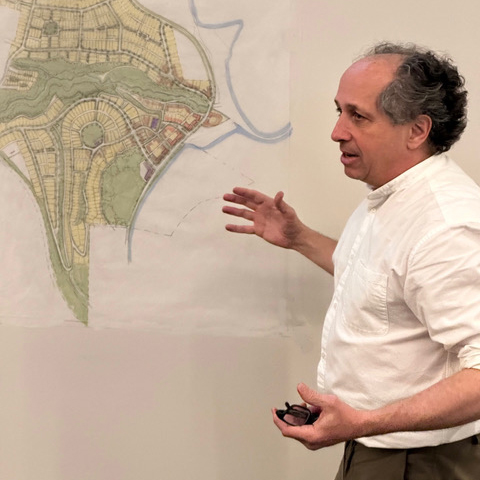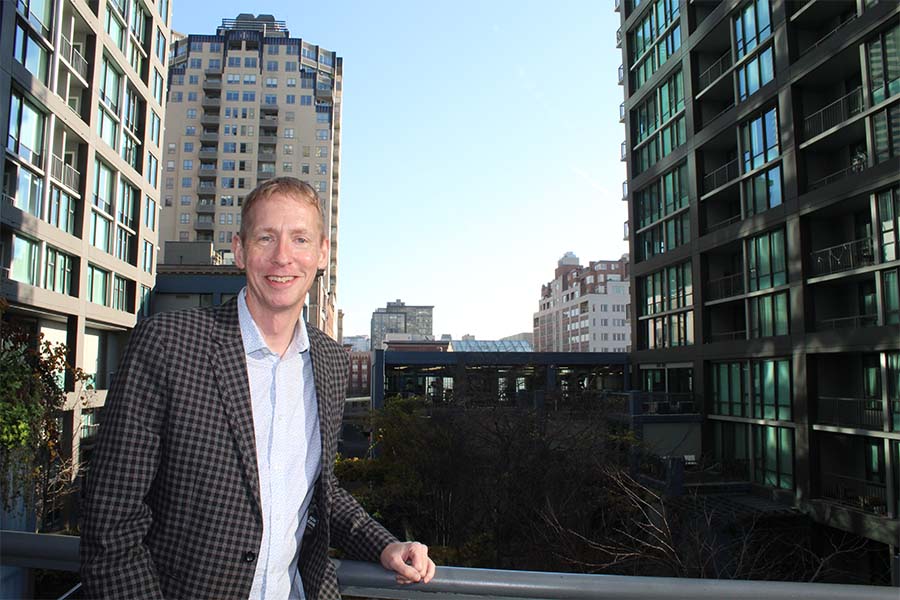Putting Residents First
From Urban Settings to Rural Destinations, CFA Alumni Are Fostering Equitable, Ecological and Economically Diverse Communities
School of Architecture
written by
Pam Wigley
Neighborhoods are nothing without their people, but the design of communities gives greater meaning to people’s lives. So, planning them will not be successful without first considering what’s important to residents, whether those residents are part of an urban cityscape or a rural town or village.
Few know better than David Kunselman and Laurence Qamar, both graduates of the Carnegie Mellon School of Architecture. Kunselman (B.Arch. 1990) is the director of capital development for the City of Seattle, and Qamar (B.Arch. 1985) owns and operates his own architecture and urbanism firm in Portland, Ore. Although they have different types of jobs, they share a common goal when building communities: You must value the residents who will live there, as well as the local culture, heritage and natural environment. Below is how both are making their mark within the industry.
Designing Communities … Not Only Constructing Buildings
Laurence Qamar, CNU-A, architect and town planner, came to Carnegie Mellon University in the early 1980s to become an architect. He achieved his goal, graduating in 1985 and following his undergrad with a master’s in architecture and town planning from the University of Miami in 1994. Given his studies, one may think that Qamar settled into the typical architect’s role of designing and constructing buildings, but that’s not the case. Qamar found his own unique way and pursued his personal passion.
“I found the design and construction of individual buildings often limiting compared to the broader social and environmental qualities of towns and cities,” he said. “So, I went the route of urban design and walkable mixed-use planning.”
It was a good choice for him, and it opened his eyes to how his studies in the School of Architecture allowed him to tailor his interests to his strengths. Just being in Pittsburgh was a bonus, too, he said, because the neighborhoods surrounding CMU’s campus helped him to determine that he wanted to focus his life’s work on designing cities, towns, villages and neighborhoods.
Qamar was introduced to designing and planning cities from two pivotal classes taught by Stefani Ledowitz (now Danes), who he said “opened my eyes to the art and structure behind a community.” At that time, a new era of reviving traditional urban design was just emerging out of the ashes of a post-war, Modernist assault upon city centers, combined with the auto-dominated sprawl of suburbs surrounding most American cities. Danes referred her students to two important books, among others, that influence Qamar in particular: “The Death and Life of Great American Cities” by Jane Jacobs and “A Pattern Language” by Christopher Alexander. Their bookwork moved to footwork when the class set out to Pittsburgh neighborhoods like Polish Hill so they could study how the layout of the community met residents’ needs.
Doug Cooper was another of Qamar’s influences and, coincidentally, also was drawn to studying Pittsburgh neighborhoods such as the Polish Hill community.
“Doug taught us new ways to see and represent the world around us through the practice of drawing,” Qamar said. “He taught us to perceive the volume of space, not only the solidity of form. It was a way to open our eyes and minds [to something] that was completely new to me.”
Qamar met his future wife, Geraldine “Gerri” Ondrizek, when she was installing her sculptural work in one of the top floors of the College of Fine Arts Building. An art major who earned her BFA in 1985, Ondrizek was living with a group of architects; she and Qamar became good friends. They reconnected several years after graduating and their friendship blossomed. They married in 1996.
Following his graduation from CMU, Qamar followed his dream of creating sustainable communities after working in various design and project management roles in multiple cities — from New York City, to Aspen, followed by his graduate degree in Miami, and eventual move to Portland.
After working for his grad school professors, Duany-Plater-Zyberk in Miami, and their associates in Portland over an eight-year period, he founded and became principal of Qamar & Associates in Portland in 2002. He and his team dedicate their talents to the design and implementation of “vibrant, healthy and sustainable communities.” Since its founding in 1994, he has been an ongoing active member of the Congress for New Urbanism (CNU).
“I plan and design new villages, towns and neighborhoods, as well as [create] revitalization plans for old downtowns and retrofitting of suburban areas into walkable, bikeable and transit-oriented neighborhoods,” Qamar said.

“The primary objective is to create walkable, mixed-use neighborhoods in which residents can live, work, shop, learn and recreate — all within a 5–10-minute walking time."
Laurence Qamar

This way of living, Qamar said, harkens back to how humans lived for millennia, but that way of life was cut short in the era of cars and Modernist city planning. His goal is to create living communities where people can walk, bike and take transit in addition to driving. In this way, people can engage with their neighbors and fellow community members. Seabrook is one exemplary community conceptualized and brought to reality by Qamar and his colleagues.
Founded in 2004 by Casey and Laura Roloff, Seabrook is Washington state’s most beloved “beach town,” overlooking the Pacific Ocean from a beautiful scenic bluff. The community features craftsman-style houses in nine small neighborhoods and boasts year-round residents, renters and vacationers. It’s heralded by many as the perfect seaside town.
Through Seabrook and his firm’s other projects, Qamar remains focused on what community residents need and where people can “experience the difference between late 20th Century suburban auto-oriented sprawl and compact, healthy, sustainable communities,” he said. “There’s still too much low-density suburban sprawl being built globally, and we need to curb that trend."
Kunselman Makes City Planning Personal

It all started with Sleeping Bag Weekend, an activity David Kunselman participated in at Carnegie Mellon when he was considering colleges. Immersing himself in the campus and activities that weekend, Kunselman didn’t need to look further. CMU was his choice and his only college application.
The middle of three children from rural Fenelton, Pa., Kunselman had a strong interest in math and science and looked for creative outlets growing up. Those talents would come in handily as he pursued his studies in architecture at CMU. He said he found great support in the teaching staff and faculty, but there was one particularly influential person in the School of Architecture main office.
“Judy Kampert made it happen,” he said, smiling as he thought about her. “She knew all the behind-the-scenes connections to everyone and everything. Plus, she really taught all of us students how important it is to build relationships in whatever we do.”
He also gives a nod to his fellow students as inspiration in his own education. Classmates would share advice and experience with each other, and Kunselman found it beneficial and eye-opening. The curriculum in the School of Architecture made a lasting impression on Kunselman, too, particularly learning about the ability to understand the design process and synthesize information, keeping the community close to mind when working on a project of any type.
“It’s an inherent part of my education,” Kunselman said. “I use that approach and thought process all the time in my work.”
Another fond Pittsburgh memory involved seeing his childhood idol, Fred Rogers, walking across campus. A friend had access to WQED, where the show was taped, and took Kunselman to the set of “Mister Rogers’ Neighborhood.” The experience was a good distraction from the architecture studios and remains one of the highlights of his time at CMU.
Kunselman became president of the American Institute of Architects Student Chapter while at CMU and, later, rose to national vice president of that organization. During his time in Washington, D.C., and with travel experiences as part of that role, Kunselman made contacts from across the U.S. and was drawn to people from the Pacific Northwest. He targeted Seattle as a place to settle and begin his career, continuing his education by studying construction management at the University of Washington and passing the Architect Registration Examination to earn his architecture license.
Kunselman worked his way upward through a variety of roles in Seattle and the surrounding metro region, each one representing the public client. He began working for the City of Seattle in 2007 as the manager of a levy program that upgraded or replaced all the city’s fire stations. Kunselman has managed many civic projects since then and currently serves as director of capital development for the City of Seattle.
Regardless of the projects before him, Kunselman said he returns to the principles he learned at the School of Architecture — namely, keeping the impacts of each project on community residents in mind. Every undertaking, he said, is an extension of people in their community. For instance, Kunselman has designed many neighborhood libraries while representing the King County Library System and Seattle Public Library. Even before putting pencil to paper for sketching, he does his homework.

“Just visiting the neighborhood is helpful,” he said. “We hold listening sessions and public meetings, as well, to talk with residents about what they truly need. You must ask yourself, ‘What does the library actually mean to this community?’ Designing a library is like designing a living room for a neighborhood.”
David Kunselman
It’s evident when Kunselman talks about his work that he is still excited to approach new challenges.
“Every project is very different,” he said. “So, it never gets old. It’s always a challenge. What changes is the client and that client’s needs. Listen to them and learn from them.”